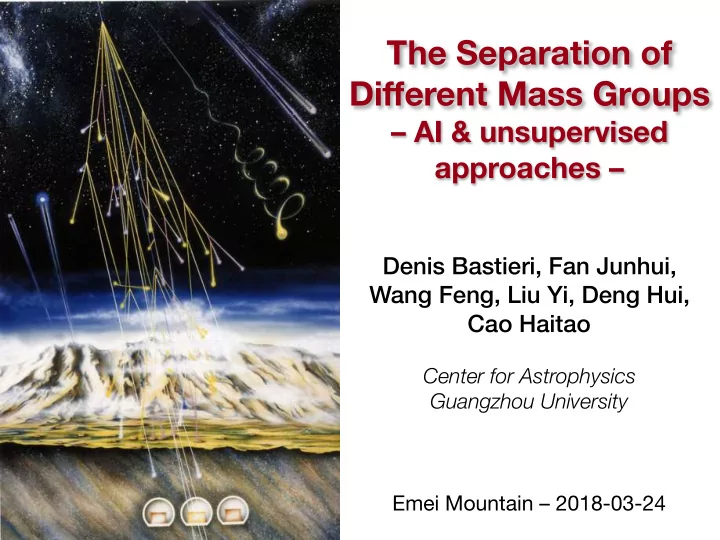

The Separation of Different Mass Groups – AI & unsupervised approaches – Denis Bastieri, Fan Junhui, Wang Feng, Liu Yi, Deng Hui, Cao Haitao Center for Astrophysics Guangzhou University Emei Mountain – 2018-03-24
Measuring nuclear mass at ground level • Indirect measurement, heavily relying on Montecarlo. • Inelastic cross-section is proportional light heavy E =100 TeV nucleus nucleus to A ⅔ , so that light nuclei penetrates deeper into our atmosphere. • In addition, as A increases, so does Z , and the number of μ produced . (prob. maybe skewed by toy-MC…) • So there are mainly two e ff ects as A increases: • the shower ripes earlier, and at lower altitudes it is then smother , • the number of μ produced increases, ⇒ muons carry large transverse momenta, depleting the core. D. Bastieri, LHAASO@Emei , March 24, 2018 2
Composition at the knee: KASCADE The knee in the all-particle spectrum is due to the bending of the light (proton) component ] 4 10 1.7 proton spectrum ] QGSJet 01 AMS Sokol-2 1.5 GeV BESS JACEE GeV 5 Caprice RUNJOB 10 3 10 -1 -1 Ryan Tibet sr sr HEGRA -1 -1 s s -2 2 10 -2 [m [m 2.5 4 10 E proton 2.7 10 . dJ/dE helium E carbon dJ/dE . KASCADE proton, QGSJet 01 analysis 1 KASCADE proton, SIBYLL 2.1 analysis 6 7 8 10 10 10 3 10 primary energy E [GeV] 2 3 4 5 6 10 10 10 10 10 4 10 SIBYLL 2.1 energy E [GeV ] ] 1.5 GeV 3 10 -1 from the analysis of the nearly vertical shower set: The knee is ob- sr served at an energy around � 5 PeV with a change of the index -1 s D c � 0 : 4. Considering the results of the mass group spectra, in all -2 2 10 [m analyses an appearance of knee-like features in the spectra of the light elements is ascertained. In all solutions the positions of the 2.5 proton E knees in these spectra is shifted to higher energy with increasing 10 helium . dJ/dE element number. carbon Astroparticle Physics 24 (2005) 1 1 6 7 8 10 10 10 sea level primary energy E [GeV] Astroparticle Physics 31 (2009) 86 G. Di Sciascio, Padova , Jan. 31, 2018 3
Composition at the knee: KASCADE J(E) (m 16 10 4 10 ] 1.5 QGSJet 01 GeV 2.5 silicon Scaled flux E 3 -1 10 15 iron 10 sr He - Si -1 s -2 H [m 2 10 HERA ( -p) γ 2.5 14 10 RHIC (p-p) E Fe dN/dE 10 13 10 13 10 1 6 7 8 10 10 10 energy E [GeV] SIBYLL 2.1 ▼ KASCADE M.B. Comptes Rendus (2014) ▲ KASCADE-Grande The knee in the all-particle spectrum is due to the bending of the light (proton) component γ Helium or carbon the most abundant element at knee silicon iron Energy threshold ≈ PeV 19 20 10 10 6 7 8 10 10 10 energy E [GeV] G. Di Sciascio, Padova , Jan. 31, 2018 4
Toy Montecarlo • Used CORSIKA as installed with corsika+simtel-array (CTA) • Simulated 10,000 p at 10 TeV (and saved only electrons and muons ). Height of first interaction 14,410 m s.l.m. • Z ~ Schimmerling & al. model (2004) • A ~ simulated to be within band of stability: used to compute the height of first interaction. • Superposition : nucleus behaving as A protons interacting from the height of first interaction (protons randomly picked from the pool of simulated protons) • Shower sampled at 4,410 m s.l.m • Removed 20% of hits (to simulate efficiency ) • Known issues: p cascades di ff erently at di ff erent heights and many others… D. Bastieri, LHAASO@Emei , March 24, 2018 5
Dichromatic images • The idea is to use a dichromatic image, using for the red channel the density of muons and for the green channel the density of electrons . • The array side extends ±40 m for a quick cross-check with ARGO. • Hits saturated at 8 bits (almost no bias) for electrons . • Densities computed in bins of area, results smoothed, 22 bins on side ~2 × finer than ARGO. • Images are 22 × 22 pixels, upsampled to 32 × 32 pixels for a faster implementation (as I had already a working FCN). • FCN (Fully Convolutional Network) handed using cuDNN and NVIDIA/DIGITS. D. Bastieri, LHAASO@Emei , March 24, 2018 6
Results • Simulation in fair agreement with ARGO. • Need to revise some potential issues in simulation (CR composition in Z and A , height of first interaction, longer range of interactions for nucleons in the Superposition technique, di ff erences between p and n …) • Results optimized to give 26 for xx Fe . Data were rounded to the next integer. Reconstructed Z • A rtifacts need to be understood. • No bkg in simulation ¿abnormal waist at Z = 1? • Graph doesn’t show the occupancy of each dot! • Still, the analysis shows some Real Z promising trends! D. Bastieri, LHAASO@Emei , March 24, 2018 7
Recommend
More recommend